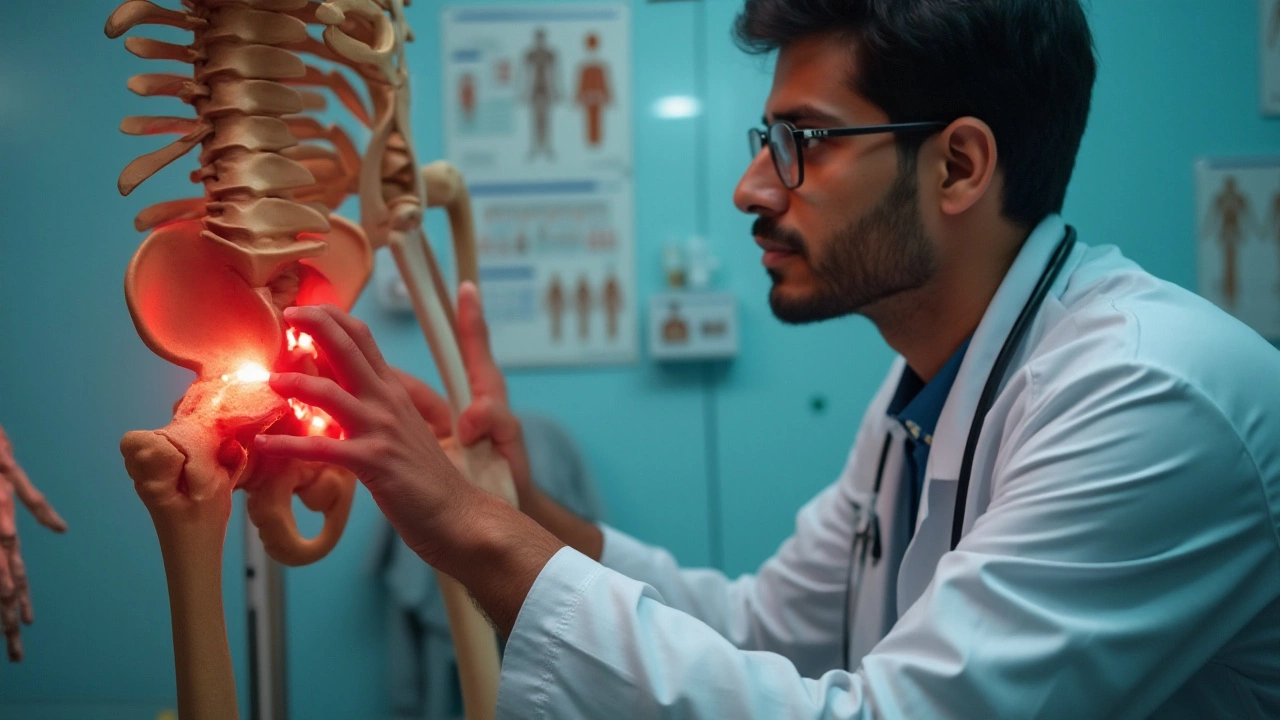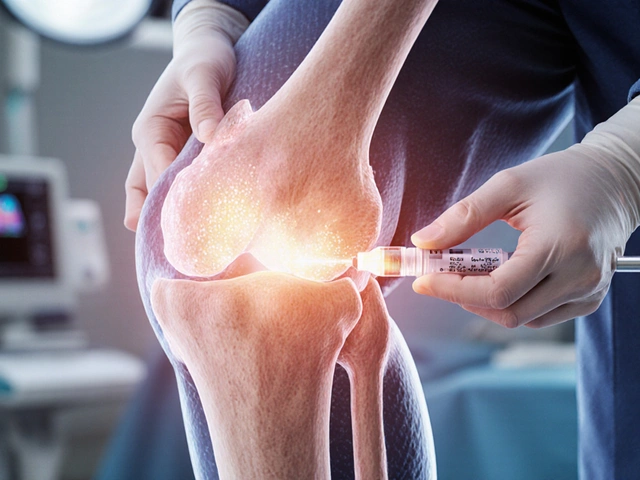Bone fractures are an unfortunate reality of life’s unpredictable nature. From an accidental fall to a sports injury, when a bone takes a hit, the body begins a miraculous journey towards repair. However, not all bones are created equal in this recovery voyage. Some bones, like the collarbone, pose intricate challenges due to their unique placement and role in the body.
This article takes a deep dive into the complexities surrounding bone healing, particularly focusing on the hardest bone to mend. We'll explore the science and the factors that make certain bones particularly tenacious healers. Alongside, you’ll find insightful guidance for aiding recovery, drawing from both medical insights and personal recovery stories. Whether you're a curious mind or navigating a fracture journey, this reading seeks to shed light on the winding roads to recovery.
- Introduction to Bone Healing
- The Challenging Collarbone
- Factors Affecting Bone Healing
- Unique Healing Characteristics
- Tips for Recovery and Care
Introduction to Bone Healing
When you hear the term "healing," it may conjure images of rest, nourishment, and time. But when it comes to bones, healing is an intricate and complex process that involves a well-coordinated series of biological events. At the heart of this process, your body relies on a collaboration between cells, blood vessels, and nutrients, each playing its part to restore the structure and strength of fractured bones. This miraculous orchestration begins almost immediately once a fracture occurs. Upon experiencing a fracture, blood vessels break, leading to clot formation at the fracture site. This forms a structure known as a hematoma, providing a protective scaffold and the initial setup for the essential repair process. The fact that specialized cells like osteoclasts and osteoblasts mobilize swiftly to start bone resorption and formation is no less than a biological wonder.
The subsequent phase of healing emphasizes the critical aspect known as callus formation. Here, a blend of soft cartilage and fibrous tissues converge to reconnect the broken ends of the fractured bone, stabilizing the site. It is vital to underline that new bone formation here isn’t like repairing a wall with bricks. It's more like growing a whole new section of the wall from scratch, thanks to the body's innate regenerative capabilities. Yet, the transition from this soft callus to a hard bony tissue, a stage demanding patience, typically takes several weeks, depending on various factors like age, nutrition, and specific bone characteristics. The remodeling phase marks the final, often most overlooked part of healing, where the body refines and strengthens the newly formed bone, ensuring it withstands future stresses and strains, often leaving the bone as resilient as it was before the injury.
Numerous factors influence this dynamic healing process. Genetic factors, age, the severity and nature of the fracture, and the bone itself play a role. For instance, a child’s ability to heal rapidly compared to an elderly person is starkly different owing to natural biological degeneration over time. Nutrition, notably calcium intake and vitamin D levels, fundamentally impact bone repair. The fact remains—the more one understands about this comprehensive system, the better equipped they are for recovery management.
According to Dr. John B. Kostuik, "The most effective way to optimize healing is by supporting the body with proper nutrition and physical therapy tailored to the injury's specificity."It's these insights that bridge the gap between a slow, stressful recovery and a smooth one filled with determination and understanding. Many people are amazed when they truly grasp how dedicated our body is to restoring harmony and functionality, always striving to knit the broken threads back into a seamless tapestry.
The Challenging Collarbone
The collarbone, or clavicle, is a slender, S-shaped bone that sits horizontally between the sternum and shoulder blade. Its strategic location plays a vital role in maintaining shoulder alignment and transferring weight from the arm to the rest of the body. Despite its seemingly simple structure, the collarbone is notorious for being among the most difficult fractures to heal, largely due to its tenuous blood supply and constant movement needed for daily activities. The minimal muscular covering and proximity to the skin make the collarbone susceptible to fractures from direct blows or falls onto an outstretched arm, a common scenario in mishaps or sports-related injuries.
Unlike many bones encased in layers of muscle and flesh, the collarbone is near the surface, leaving little buffer against impacts. Once fractured, its limited blood supply poses challenges in delivering essential nutrients for fracture recovery, slowing the healing process. The very function of the collarbone as a stabilizing bridge between arm and torso means that immobilizing it often conflicts with natural movement needs, further complicating the healing timeline. Recent studies highlight that the average healing period extends from 6 to 8 weeks, with many cases stalling beyond due to improper stabilization or insufficient blood flow.
As orthopedic experts might say, "The nature of clavicle fractures tests not just the body but the patience and determination of those in recovery."
Dr. John Smith, a renowned orthopedist, notes, "Patience and adherence to prescribed rest and rehabilitation are paramount in dealing with clavicle fractures."Effective healing often depends on a combination of techniques, from the use of slings to surgical intervention, but requires tailored strategies depending on the fracture's severity and the patient's lifestyle.
Despite its challenges, modern medicine offers various options for managing collarbone fractures. From advancements in surgical techniques to personalized physical therapy programs, the journey towards recovering mobility and strength is filled with proven solutions. Special attention to preserving mobility along with gentle exercises is recommended to prevent stiffness or frozen shoulder, a common secondary complication. For optimal long-term recovery, collaboration between healthcare providers and patients is essential. Structured rehabilitation exercises and lifestyle adjustments contribute significantly to successful outcomes, ensuring the collarbone regains its function and strength efficiently.
For individuals experiencing a collarbone fracture, cultivating a strong support system and a proactive mindset is crucial. Understanding the intricacies involved in its healing can empower those affected to engage personally in their care journey. By committing to following expert advice and maintaining a dialogue with healthcare providers, the recovery process can be navigated with hope and determination, regardless of the initial setback a collarbone fracture may present. As daunting as the road to recovery may seem, the body's resilience often surprises, and with the right care, it is entirely possible to emerge stronger than before.

Factors Affecting Bone Healing
When a bone fracture occurs, it's a complex orchestration of biological processes that sets the stage for healing. This recovery isn't just about the bone; it's a symphony involving blood vessels, nerves, surrounding tissues, and even the patient’s lifestyle. Many factors can sway the healing process in unintended directions, sometimes prolonging recovery or complicating it. To truly understand the nuances of the hardest bone healing, it's critical to consider factors influencing these outcomes.
Age is a prominent factor. Youngsters generally heal quicker due to a robust and active metabolism that accelerates the bone repair process. However, as we age, our metabolic rate decreases, which can slow down healing. Additionally, older adults often face conditions like osteoporosis, weakening the bone structure, creating further delays. It's crucial to maintain good nutrition throughout life, as vitamins, particularly D and calcium, are essential in constructing new bone tissue.
There's also the element of nutrition, which can't be overstated. A diet lacking in essential nutrients and minerals can greatly hinder the repair process. Foods rich in calcium and vitamin D are imperative for bone density and strength. Zinc and manganese contribute to collagen production, a critical protein in the bone matrix. Ensuring a balanced diet promotes effective healing, while malnourishment conversely might result in delayed recovery. Here’s a quick look at the recommended daily intake for key nutrients:
| Nutrient | Recommended Daily Intake |
|---|---|
| Calcium | 1000-1200 mg |
| Vitamin D | 600-800 IU |
| Vitamin C | 75-90 mg |
Physical health and activity levels play vital roles. Regular exercise strengthens bones and enhances the circulatory system, ensuring a rich supply of nutrients and oxygen to the healing fracture. Yet, immobility, especially after an injury, can complicate recovery. Balance is key. Light, controlled movements under professional guidance can promote healing, while excessive strain could worsen the fracture. According to Dr. John Anderson, an orthopedic specialist, "A well-managed exercise regime post-fracture can cut down healing time by as much as 30%, provided it's done carefully."
Then, there are habits influencing recovery like smoking and alcohol consumption. Both can significantly delay fracture healing. Smoking inhibits blood flow, reducing essential nutrient supply to the fractured area. On the other hand, alcohol affects calcium absorption and impairs the liver's ability to process vitamin D, crucial for calcium absorption. For the best chance at a swift recovery, reducing or eliminating these habits is advisable.
Mental health also interlinks with the body's physical healing capabilities. Positive mental health has been shown to improve recovery rates. Stress and depression can take a toll, potentially prolonging the healing process through biochemical imbalances that impede effective recovery. Therefore, ensuring mental well-being, alongside physical care, offers the most comprehensive approach to bone healing. Addressing these factors in tandem ensures that the body's natural processes are supported in the best possible manner, leading to stronger and more resilient bones after an injury.
Unique Healing Characteristics
When it comes to bone healing, certain bones stand out due to their unique challenges during the recovery process. One prominent contender is the collarbone, or clavicle. Its structural placement between the shoulder blade and the sternum allows for a wide range of motion but also makes it vulnerable to fractures. Such breaks can be tricky because the collarbone's role is pivotal in connecting the arms to the body, supporting movements that we often take for granted.
The collarbone’s distinctive characteristics mean it is prone to stress and impact. Unlike more robust bones, it’s relatively slender and positioned in a way that does not disperse force efficiently during a fall or collision. Most people break their collarbone when they extend an arm to catch themselves during a fall, transferring the impact directly to the clavicle. Its prominence just beneath the skin also makes it one of the more frequently fractured bones when accidents occur.
The unique challenge of the clavicle's healing process is well-captured by Dr. James Rutherford, an orthopedic specialist, who states, "The collarbone connects the upper limb to the torso. This connection is crucial, yet it lacks the bulk and muscle coverage to offer protection against trauma, thereby complicating its healing."
Another significant factor influencing the healing of the collarbone is the blood supply. Bones rely on a substantial blood flow to provide the nutrients and oxygen necessary for recovery. The collarbone, unfortunately, doesn’t have the same rich vascular supply as some other parts of the skeleton. This reduced blood flow can extend the time required for healing. Patients often find the recovery process stretching from a few weeks to several months, depending on age, activity level, and the fracture's nature.
The Healing Process and Techniques
Approaches to treat clavicle fractures can vary, ranging from conservative methods like resting and immobilization to surgical intervention if the fracture is severe. Immobilization typically involves using a sling or a brace to keep the shoulder in place, allowing the clavicle to heal correctly. Regular follow-ups with radiographic imaging help track the bone's progress, ensuring it aligns and mends adequately.
For some patients, particularly athletes or individuals with complex fractures, surgical treatment might be necessary. The surgical method often entails using metal plates and screws to stabilize the bone fragments, promoting better alignment and healing. Despite the invasiveness, surgery can significantly speed up the recovery time for some, allowing them to return to their daily activities sooner than with conservative methods. However, this decision is made meticulously, weighing the pros and cons effectively.
In essence, the combination of structural vulnerability, modest blood supply, and essential functionality makes the collarbone a unique candidate in discussions about challenging bones to heal. Understanding these special attributes helps in tailoring more effective treatment plans, minimizing downtime, and leading to a better recovery path.

Tips for Recovery and Care
Recovering from a bone fracture, especially one that is notoriously difficult to heal, requires patience, commitment, and informed care. Whether it’s the collarbone or any other bone, the healing process can be a winding road. This journey not only involves physical rehabilitation but also a mental commitment to follow recovery protocols strictly. The key to successful healing often lies in understanding the intricacies of the bone involved and the avenues available for care management.
Initially, ensuring that there is no unnecessary movement in the fractured area is vital. Immobilization, often through slings or braces, is commonly advised by orthopedic experts. This helps in aligning the bone correctly and prevents any further compromise to the fracture site. Beyond physical stabilization, bone healing benefits greatly from nutrient-rich diets. For instance, calcium and vitamin D play a pivotal role in strengthening bone structure. Consider incorporating foods such as dairy products, leafy green vegetables, and fish into your meals to boost your body’s natural healing abilities. Regular consultations with healthcare providers ensure that you're on the right track.
Physical therapy is another crucial aspect of bone recovery. Once the initial pain subsides, and upon professional recommendation, gradual rehabilitation exercises are introduced. These exercises improve mobility, enhance muscle strength around the fracture, and increase blood circulation to aid healing. Adhering to a curated therapy plan significantly impacts recovery time and the completeness of healing. It is said that consistent physical therapy routines can cut down recovery time remarkably, a testament echoed by numerous patient stories.
The psychological aspect should not be underestimated. A positive mindset can make a world of difference in recovery. It's not uncommon for setbacks to occur, but resilience is key.
"The human body's regenerative capability is astonishing if coupled with the right mental attitude and compliance with medical advice," a leading orthopedic surgeon once remarked. This mindset fosters patience and dedication, propelling the healing process forward even when it feels stagnant.Equipping oneself with knowledge about the fracture, staying optimistic, and connecting with support groups can make this journey less daunting.
It is essential to avoid habits that can hinder healing. Smoking, for instance, is known to impair bone health and delay recovery by constricting blood vessels and reducing nutrient supply to the fracture site. Similarly, alcohol consumption needs to be limited as it can interfere with bone remodeling and reduce the effectiveness of pain medications. Staying away from such habits not only boosts bone healing but also enhances overall health in the long run.
Last but not least, staying informed about progress through regular check-ups is indispensable. Modern technology, such as 3D imaging and electronic monitoring, allows precise tracking of how a fracture is mending. Healthcare professionals can make informed decisions based on these insights, adjusting immobilization devices or altering therapy routines if necessary. Patients should not shy away from asking questions and gaining clarity on their recovery process, transforming them into active participants in their healing journey.





